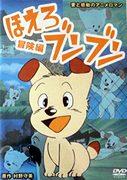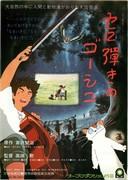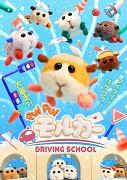The appeal and evaluation of "Hoero Bun Bun": A must-read review for anime fans

Hoero Bun Bun - Hoero Bun Bun - Reviews and Recommendations■ Public MediaTV anime series ■ Original Mediacomics ■ Broadcast period October 9, 1980 - July 9, 1981 ■Broadcasting station・Tokyo 12 Channel ■Frequencieshalf an hour ■ Number of EpisodesEpisode 38 ■Original Story・Original work: Morimi Murano ■ Director・Chief Director, Director: Shigeru Omachi ・Sub-Director: Shuichi Masaki ■ ProductionProduced by Tokyo 12 Channel, Wako Productions ■ StorySoon after he was born, the puppy Bunbun was put in a mandarin orange crate and sent down a river. Bunbun sets out on a journey to find his mother, and on the way he meets Nora, a kind old dog, and many other friends, and grows stronger as he learns the skills of survival. ■ExplanationThis animal animation is based on the manga "Hoero Bobo" by manga artist Murano Morimi. It follows Bunbun, a male puppy abandoned by humans, as he grows up in a society of stray dogs. This work was broadcast in Japan in the early 1980s and continued to be loved by children. Through Bunbun's adventures and growth, it depicts friendship, family ties, and the harshness of life. The anime faithfully reproduces the essence of the original work while enriching the story through visual expression and music. ■CastBunbun/Minori Matsushima Nora/Masaaki Maeda Big/Isamu Tanonaka ■ Main staff Original story by Murano Morimi (published by Tokuma Shoten and serialized in Monthly TV Land) ■ Main Characters Bunbun is the main character. A male puppy who was abandoned by his owner, a fighting dog breeder. He becomes a stray dog and sets out on a journey to find his mother. ■Subtitle Episode 1: Searching for his mother... a puppy swept down the river (1980/10/09) ■ Theme songs and music・OP1 ■Review"Hoero Bun Bun" is a Japanese anime television series that aired in the early 1980s and is based on the manga "Hoero Bobo" by Morimi Murano. The series tells the story of Bun Bun, a puppy abandoned by a dog-fighting breeder, who grows up through his journey to find his mother. The anime depicts Bun Bun's adventures and growth, as well as the bonds of friendship and family, and the harshness of life. Bunbun's character evokes deep empathy from viewers. Abandoned at birth, he sets out on a journey to find his mother, but faces many difficulties along the way. However, Bunbun never gives up, and grows together with his friends. His story gives courage and hope to children, and is also a moving one for adults. The anime was produced by Tokyo 12 Channel and Wako Productions, with chief director Shigeru Omachi and sub-director Shuichi Masaki taking the lead. The music was composed by Keigo Kakuta and Tetsuo Ueno, and the theme song "Harukanaru Tabiji" and the ending theme "Mama no Serenade" were sung by Kaori Matsuo. These songs play a role in further deepening the emotional impact of the story. Each episode follows Bunbun's journey and explores a different theme. For example, in episode 5, "The Friendship of Lucky the Fighting Dog," Bunbun meets Lucky the fighting dog and learns the power of friendship. In episode 11, "Bunbun Fights in the Circus," Bunbun discovers his own strength through his experience in the circus. And in episode 25, "The Day I Meet Mom... Mom, It's Me, Bunbun," Bunbun is finally reunited with his mother, making for a touching story. This anime has not only been loved by children, but has also been an inspiring work for adults. Bunbun's journey gives courage and hope to viewers, and reminds them of the importance of family ties and friendship. The anime production staff faithfully reproduced the essence of the original work while enriching the story through visual expression and music. For this reason, "Hoero Bunbun" has become one of the most highly regarded Japanese television anime of the 1980s. ■Recommendation"Hoero Bun Bun" is a touching anime that can be enjoyed by both children and adults. It is especially recommended for those who like stories that depict the importance of family ties and friendship. Also, those who are interested in Japanese TV anime from the 1980s should not miss this work. Through Bun Bun's adventures and growth, viewers can feel courage and hope. We hope you will experience this touching story. Furthermore, to understand this anime more deeply, I recommend reading the original manga "Hoero Bobo." By comparing the differences between the original and the anime, you will be able to understand the background of the story and the growth of the characters more deeply. Also, I would like you to listen to the theme song "Harukanaru Tabiji" and the ending theme "Mama no Serenade." These songs play a role in further deepening the emotion of the story. "Hoero Bun Bun" is a moving anime that gives courage and hope to its viewers. Through Bun Bun's journey, viewers will be able to reaffirm the importance of family ties and friendship, and discover their own strength. This work is one of the most highly acclaimed Japanese TV anime of the 1980s, and I hope many people will see it. |
<<: "Twenty-Four Eyes": Reassessing a moving masterpiece
>>: The appeal and evaluation of the "Hoero Bun Bun" series: A must-read review for anime fans
Recommend
UNIQLO x "EVA" joint UT Chinese area has 8 models on sale on April 17
Today (April 9), UNIQLO and the famous Japanese a...
"Yurikago no Uta" review: Reevaluating the moving songs of everyone
"The Cradle Song" - A timeless classic ...
Mission: Impossible 7 wrapped filming for more than a year and will be released on September 30, 2022
Martin Smith, the lighting director of Mission: I...
The new special effects work of the Sentai team "Super Battle Junrei GER" is released this fall
The new special effects work of Japan's class...
The final makeup photos of the stage play of "Puella Magi Madoka Magica Gaiden" are released, and the cute girl is highly restored
The official stage play of the same name adapted ...
Toy Story invades Japan, stop-motion animation master releases new creative work
Japanese netizen @shinohara_kenta is a folk maste...
Nereus actor: Aquaman 2 may start filming in London this summer
Dolph Lundgren, the actor who plays Nereus in &qu...
"Kaleido Star: New Wings" Review: What is the brilliance that colors this emotional new chapter?
Kaleido Star: New Wings - moving entertainment an...
iG joins "Dungeons & Dragons: Rogue Glory" and serves as the Chinese running team
Today (March 10), the iG League of Legends team a...
"Jujutsu Kaisen" popular character Zenin Maki new figure long sword glasses Jujutsu girl
Goodsmile recently launched a new figure from the...
Brushing your teeth: The appeal and reviews of Minna no Uta
Comprehensive reviews and recommendations for &qu...
New stills of the second season of "The Last of Us" Joel, Ellie, Abby and others appeared
Recently, new stills from the second season of Th...
Hamtaro's Birthday - Searching for Mommy: A moving journey and birthday celebration
Hamtaro's Birthday: A Story of Inspiration an...
New stills and makeup photos of the Game of Thrones spin-off "House of the Dragon" released
Recently, the prequel series of "Game of Thr...
Ultraman Zero joins the battle! The new work "Ultraman Z" is confirmed to be broadcast on June 20
Today (March 26), the new work in the Ultraman se...









